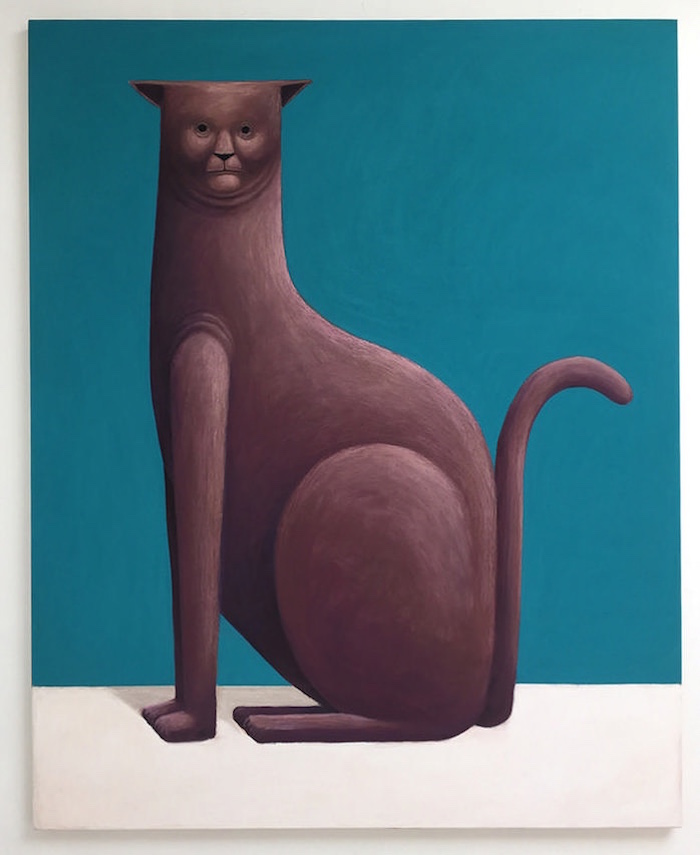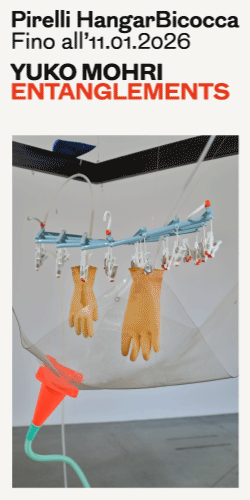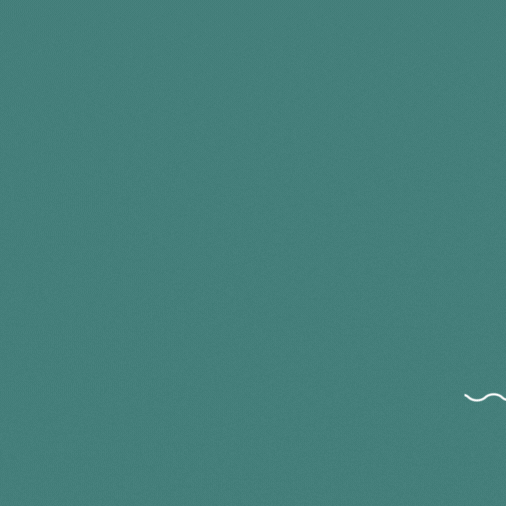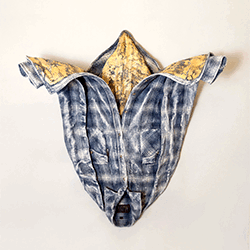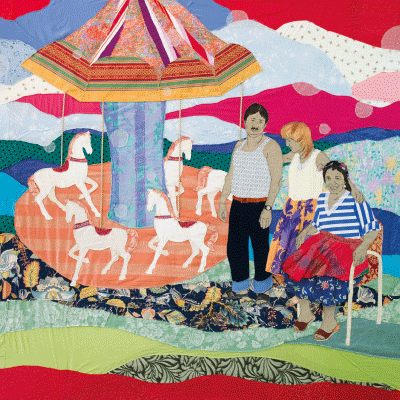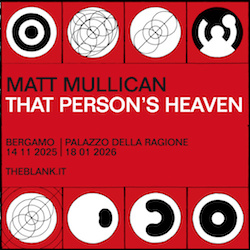
English version below
Inaugurano domani a Firenze e a Bargino, due progetti rispettivamente di Nicolas Party e Jorge Peris. Promossi da Antinori Art Project – a cura di Ilaria Bonacossa – le due mostre sono ospitate a Palazzo Antinori e nella Cantina nel Chianti Classico, a pochi chilometri dal capoluogo toscano. Un paio di giorni fa abbiamo posto all’artista spagnolo alcune domande su progetto site-specific Portal del Angel. Ora è il turno dell’artista svizzero Nicola Party introdurci la mostra Nicolas Party in the Garden Room, ospitata fino al 14 gennaio nelle stanze a Palazzo Antinori. L’occasione della mostra a Firenze è data dall’acquisizione dell’opera dell’artista “Giant Fruit” – lavoro site-specific realizzato nel 2015 per la collettiva Still-life Remix – che entra ufficialmente a far parte della collezione permanente della famiglia Antinori.
Nella mostra fiorentina Party presenta una serie di lavori prodotti tra il 2013 e il 2016: 6 opere pittoriche – 3 nuovi acquerelli e 3 sassi-scultura – che illustrano un sua personalissima interpretazione del genere della Natura Morta.
Segue l’intervista con l’artista
ATP: La tua collaborazione con la Antinori Art Project è iniziata con la mostra Still-life Remix, dove hai realizzato “Giant Fruit”. In relazione a questa grande opera – divenuta parte della collezione Antinori – mi dai una tua definizione di ‘natura morta’ pittorica?
Nicolas Party: Esistono due nomi per questo specifico genere di pittura in diversa lingue. Mi piace moltissimo la differenza tra i due e quello che ci dicono su ciò che questo tipo di pittura cerca di esplorare. In inglese, tedesco o fiammingo si dice “still life”. In francese, italiano o portoghese “natura morta”, che si traduce in inglese come “dead nature”. Questi due termini, “still life” e “natura morta”, sono composti da due parole che in qualche modo stanno in opposizione. In “still life” la parola “still” suggerisce un’idea di pausa in una linea temporale. Al contrario, la parola “life” evoca un movimento nel tempo. La stessa opposizione si presenta nella parola “natura morta”. “Natura” suggerisce un tempo infinito, mentre “dead”, cioè morto, evoca una fine del tempo. Cercare di mettere insieme due concetti opposti in un singolo oggetto, un quadro per esempio, è un’idea affascinante e ambiziosa.
ATP: Nella sede storica di Palazzo Antinori a Firenze presenti una serie di sette opere pittoriche. Con quale criterio le hai scelte? Quale relazione sussiste tra i pastelli e i sassi-scultura?
NP: In questa mostra espongo tre pastelli e tre pitture-sasso. Un pastello di un gatto viola, un altro di frutti viola e il terzo di due vasi viola. Opere che mostrano alcuni dei miei soggetti d’interesse. In più espongo alcuni dipinti su pietra. Quando espongo diversi lavori insieme nello stesso spazio sto semplicemente cercando di creare una conversazione interessante tra gli oggetti. Per esempio mi piace l’idea che le pietre possano parlare con il pastello con i frutti viola.
— La pietra-mela
“Potrei sembrare una mela, un frutto che la natura ha creato in pochi mesi e che sparirà in pochi giorni. Ma sono una pietra… Sono molto vecchia e ci sono voluti centinaia di anni per creare la mia strana forma! Il mio aspetto da mela è solo un trompe l’oeil, un po’ di trucco sulla mia pelle”
— Il Pastello con la frutta viola dice
“Ti ho scoperta pietra-mela… Anche io sono soltanto una superficie che cerca di imitare delle curve sexy per attrarre lo sguardo del pubblico. Le persone guardano le mie curve e scatenano l’immaginazione”
— La pietra-mela
“Lo so! Guarda come sono truccata da mela, un trucco un po’ troppo sfacciato secondo me.”
ATP: Nella tua ricerca è molto forte la relazione tra arte e decorazione. Come risolvi o strutturi questi due aspetti della tua ricerca?
NP: Ho frequentato la scuola d’arte a Losanna, in Svizzera. L’artista John M. Armleder è stato una figura molto importante in quell’istituzione e penso abbia influenzato molto tanti giovani artisti. Il modo in cui esplora i confini tra cosa definisce la decorazione e l’arte è sempre stata ed è tuttora una questione molto stimolante per me. Indagare questi confini e cercare di capire le differenti gerarchie culturali che esistono tra arte e decorazione o design è molto interessante per me. Oggi per esempio dire che un’opera d’arte è decorativa può essere percepito come negativo. Decorativo è percepito come qualcosa di superficiale e la superficialità non è ben vista in questo momento. E’ anche interessante vedere come la parola “decorazione” sia cambiata nell’ultimo secolo. Nel 1953 Matisse intitolò uno dei suoi maggiori lavori tardi “Grande decorazione con maschere”. Sarebbe interessante capire quanti artisti al giorno d’oggi usino queste parole in un titolo.
ATP: Le sette opere esposte sono state installate in un luogo molto particolare di Palazzo Antinori. Cosa ti ha colpito o affascinato di questo spazio?
NP: E’ la prima volta che espongo il mio lavoro in uno spazio così storico. La presenza di un affresco già esistente è una cosa molto stimolante! Giocare con il tempo e la storia è sempre un aspetto molto eccitante del fare arte. Questo contesto è particolarmente emozionante.
ATP: Ci sono dei pittori da cui trai ispirazione per l’ideazione delle tue opere?
NP: Da quando mi sono trasferito in Belgio tre anni fa ho scoperto alcuni pittori belgi che al momento sono molto d’ispirazione per me. Léon Spilliaert e William Degouve de Nuncques sono due artisti belgi simbolisti della fine del XIX e l’inizio del XX secolo. Due anni fa ho visto una mostra a Lucerna di un pittore svizzero di nome Hans Emmenegger, ed è stata una mostra tra le più stimolanti che io abbia visto recentemente. Un altro pittore svizzero di cui al momento sto esplorando il lavoro è Cuno Amiet. Sono tutti pittori attivi tra la fine del XIX e l’inizio del XX secolo. Ho anche studiato Milton Avery e Louis Eilshemius, due pittori americani dello stesso periodo. Penso di essere molto interessato e intrigato da artisti che abbiano dipinto un certo tipo di soggetti figurativi in quel periodo storico.
CS — Nicolas Party in the Garden Room – Antinori Art Project

Interview with Nicolas Party
Antinori Art Project presents “NICOLAS PARTY IN THE GARDEN ROOM” a exhibition curated by Ilaria Bonacossa (Until 14 Genuary 2017 – Palazzo Antinori, Piazza degli Antinori 3, Firenze)
ATP: Your collaboration with Antinori Art Project started with the exhibition Still-life Remix, where you realized “Giant Fruit”. In relationship with this big work – that became part of Antinori collection – could you give me a definition of painting still life?
Nicolas Party: There are two main ways of naming this specific genre of painting in different languages. I really like the two different words and what they tell us about what this specific type of painting is trying to explore. In English, German or Flemish we say “still life”. In French, Italian or Portuguese we say “natura morta” which translates in English into “dead nature”. Those two words, “ still life” and “natura morta”, are made up of two words that are somehow in opposition. In “still life” the word “still” suggests an idea of a pause in the time line. In opposition, the word “life” evokes a movement in time. The same opposition happens in the other word “natura morta”. “Natura” suggests an endless timeline and “dead” evokes an end in the timeline. Trying to put together two opposite concepts into a single object, a painting for exemple, is a fascinating and ambitious idea.
ATP: In the historical headquarters of Palazzo Antinori in Florence you present a series of paintings. With which criterion did you choose it? Which relationship does exist between the pastels and the rocks-sculptures?
NP: I’m showing three pastels and three rocks paintings for this exhibition. A pastel of a purple cat, another of purple fruits and one of two purple pots. It show some of my subjects of interest. In addition to that, I’m showing a few painting stones. When I show different works together in a same space I’m simply trying to create an interesting conversation among the objects. For example I like the idea that the painting stones could speak to the pastel with the purple fruits.
The apple stone
– I might look like an apple, a fruit that nature made in a few month an that will disappear in a few days. But I’m a stone…I’m so old and I took thousands of years to have this funny shape! This apple look is only a trompe l’oeil, some make up on my skin”
The Pastel with the purple fruits says
– I get you apple stone… I’m also a surface trying to mimic sexy curves to attract some viewers. They’re looking at my curves imagining things.
The apple stone
– I know ! Look how I’m apple painted, a bit too suggestive if you ask me
ATP:In your research the connection between art and decoration is very strong. How do you determine and structure these two aspects of your work?
NP: I did my art school in Lausanne in Switzerland. The artist John M Armleder was a very important figure there and I think he influenced a lot of young artists. How he is exploring the boundaries and what defines decoration and Art was and are still very inspiring questions for me. Questioning those boundaries and trying to understand the different hierarchy that culturally exist between art and decoration or design is very interesting to me. Today for example saying that an artwork is very decorative can be perceived in a very negative way. Decorative is perceived as something superficial and superciality is not well valued at the moment. It’s also interesting to see how the word “decoration” has changed status in the last century. In 1953 Matisse called one of his major late work “ large decoration with masks”. It would be interesting to see how many artists are using this words in a title nowadays.
ATP: The paintings have been installed in a very peculiar place of Palazzo Antinori. What did strike or fascinate you of that place?
NP: It’s the first time that I show my work in such an historical place. The presence of an existing mural is of course a very exciting thing! Playing with time and history is always a very exciting aspect of making art. This is a context that is particularly exciting.
ATP: Are there some painters which you draw inspiration from?
NP: Since I moved to Belgium three years ago I discovered a few Belgium painters that are very inspiring at the moment. Léon Spilliaert and William Degouve de Nuncques are two Belgian symbolic artists from the late 19th and early 20th century. Two years ago I saw a show in Lucerne of a Swiss painter called Hans Emmenegger, this show was one of the most inspiring exhibition that I saw recently. Another Swiss painter that I’m looking at at the moment is Cuno Amiet. All these painters were active during the late 19th and early 20th century. I have also been looking at Milton Avery and Louis Eilshemius, two American painters again from the late 19th and early 20th century. I think I’m very intrigued and interested by artists that painted a specific type of figurative subject in that period.


